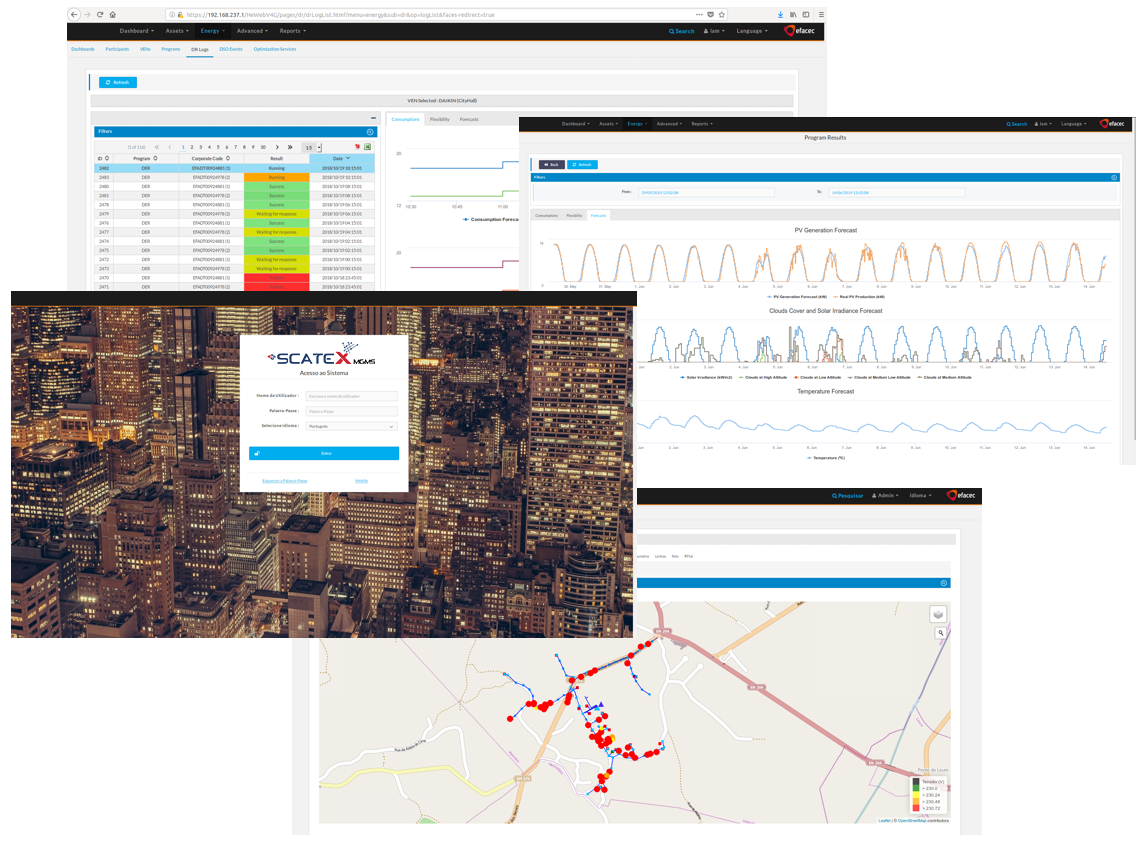| » Developed Technologies |
 |
 |
The "ES Controller" is a programmable logic device integrated in the DEMOCRAT solution. It performs as a direct controller of battery energy storage systems and their equipment, such as battery inverters, battery racks and other supporting field equipment, executing critical operating and monitoring functions under the supervision of the higher-level "ES Manager" component, while providing field and alarm data to higher-level data-oriented components.
The solution was implemented with the IEC 61131-3 standard structured text language. Its development was carried out with the Automation Studio, an Efacec's in-house configuration tool. The implemented functions are streamlined for simplicity and flexibility, featuring several function inputs that customize the basic operations of the system. The "ES Controller" is suitable for remote configuration. In this way, the "ES Manager" may send new operational parameter setpoints to the "ES Controller", which will shape the role of the implemented functions. |
| |
|
The ES Controller provides the following features:
- Peak Shaving on the point of delivery, limiting energy consumption from the grid by the overseen circuit;
- Capacity Firming of PV and wind generation, by dynamically compensating gaps in generation with stored energy;
- Generation/Load Following along the lines of a forecast of either generation or load, ensuring desired behavior at all points of operation;
- Power Factor Regulation, performed in parallel with other modes of operation, by injecting or absorbing reactive power;
- Monitoring the system during these operations, triggering alarms and engaging system protections as deemed necessary.
|
|
 |
The ScateX MGMS (Micro-grid Management System) is a comprehensive platform by Efacec, specifically designed for the operation and management of microgrid-based applications, ranging from industrial prosumers and condominiums to medium size electrical networks such as islands and remote communities that are either deprived of a connection to a main electrical grid or this connection, when existing, does not fully meet the local operation needs (weak connections to the main grid).
ScateX MGMS first aim is to ensure safe grid operation, in both grid-connected and islanded modes, following technical economic criteria while targeting high standards of energy efficiency and quality of service. For this purpose, the system has two main different operation modes:
- Operation Planning Mode - it computes in advance (up to 24h) the operation point of each controllable device based on results provided by its grid modelling, forecasting and optimization tool;
- Real-Time Operation Mode - driven by the real-time online monitoring tool, which is continuously computing the full grid operation state, it adjusts the operation point of the assets to cope with the discrepancies observed to the planned operation (e.g. due to inherent uncertainty of EV charging needs).
These operation modes are leveraged by the built-in Head-End module of the ScateX MGMS that performs autonomous data collection and communication infrastructure management of the field devices (e.g. smart meters, data concentrators, smart sensors, and other meter system communication devices).
The projected operation by the MGMS is then locally ensured by the controllable devices in the field, namely Efacec’s Energy Storage Controller, which plays an important role thanks to its capability to adjust the power output of the battery system almost instantaneously.
|
| |
 |
|
 |
|
One of the DEMOCRAT project goals is the development of the new range of battery inverters of Efacec for the specific energy storage business portfolio, based on the EFASOLAR inverters’ technological platform. Within DEMOCRAT, two new firmware versions were developed, namely the "EFASOLAR Storage 100" and the "EFASOLAR Storage 250", respectively used in the BatLab – battery laboratory – and used in the demonstrator, the latter corresponding to the effective project outcome, rated to provide 250 kVA.
The EFASOLAR Storage 250 acts as a major piece in a battery storage system, being the active link that provides the means to convert the energy from the battery modules into the low or medium voltage power grid. The power conversion system integrated on these Inverters consists of a robust pulse-width modulated (PWM) inverter with field proven components and an advanced control system, along with d.c. and a.c. switchgears and filtering components.
Being part of the system overall control chain, the EFASOLAR Storage 250 integrates a set of advanced control and operational algorithms contributing for optimum plant operational profile and maximum yield according to the battery conditions and operational setpoints, ensuring always the operational safety of the storage system’s battery banks.
The EFASOLAR Storage 250 is prepared to receive operational setpoints from a dedicated plant controller and to report in the same manner all the preponderant information regarding its operational status. In the case of the DEMOCRAT project, the EFASOLAR Storage 250 communicates and interacts with the ES Controller. Additional communication layer features are also integrated in order to autonomously react to control communication issues and/or general failures ensuring the safety of the batteries which, otherwise, may result in total loss and/or damage of the system.
Allowing for a fully integrated and operational solution, the EFASOLAR Storage 250 allows for optimal and total control of the operational profile:
- Operational capability on all 4 quadrants;
- Autonomous Grid supporting capabilities according to the applicable grid standards;
- Battery charge and discharge parameterizations independently of battery type and model, for both CC (Constant Current) and CC/CV (Constant Current/Constant Voltage) stages;
- Grid Forming capabilities, as well as the compliance with Off-Grid to On-grid transitions and vice versa.
It is also important to underline that the EFASOLAR Storage 250 equipment is an Efacec inhouse solution, fully developed according to Efacec extensive know-how and expertise in terms of equipment topology and control layer, with the resource of the most recent and advanced simulation, development and test techniques and tools.
As a conclusion, the new Efacec battery inverter family, which comprises the EFASOLAR Storage 250 inverter, was developed within the DEMOCRAT project, whose main development outcome corresponds to the specific firmware features highlighted above. |
| |
|
|
|